Abstract
Objectives:
To identify the reproductive health issues associated with adolescence and their readiness to avail services like Adolescent Friendly Clinic (AFC) among rural school going children.
Materials and Methods:
A quantitative survey was carried out using a self-administered structured questionnaire among 768 (428 boys and 340 girls) students from 15 schools by systematic random sampling from schools (3 schools from 5 talukas). Focus group discussions, 5 each with adolescent boys and girls and teachers were held.
Results and Discussion:
Only 31% of the boys and 33% of the girls mentioned that they had heard about contraception. More than half of the adolescent boys and girls knew correctly about various modes of transmission of HIV/AIDS. A large proportion of boys and girls have mentioned changes in the opposite sex such as increase in height, change in voice, breast development, and growth of facial hair, growth of hair in private parts, onset of menstruation in girls, etc. Nearly 70% of adolescents were ready to use AFC. Teachers perceived that adolescents become curious about the changes taking place in them, but they lack information and opportunities for open-discussions to get answers to their queries related to reproductive health. They are willing to take help from teachers but teachers are not equipped with knowledge nor are they comfortable discussing these issues with their students.
Recommendations:
Information on the human reproductive system and related issues on reproductive health need special attention. Teachers’ sensitization to “adolescent health care” is required.
Keywords: Adolescents, reproductive awareness, rural
INTRODUCTION
World Health Organization (WHO) defines adolescence as the period of life between 10 and 19 years of age. The adolescent experiences not only physical growth and change but also emotional, psychological, social, and mental change and growth. Physiological changes lead to sexual maturity and usually occur during the first several years of this period.[1] Adolescence represents a window of opportunity to prepare for a healthy adult life. The world's adolescent population -1200 million persons, 10-19 years of age, or about 19% of the total population-faces a series of serious challenges not only affecting their growth and development but also their livelihood as adults. Yet adolescents remain a largely neglected, difficult-to-measure, and hard-to-reach population, in which the needs of adolescent girls in particular are often ignored.[2] Adolescence is a period of increased risk taking and therefore susceptibility to behavioral problems at the time of puberty and new concerns about reproductive health.[3] Majority of adolescents still do not have access to information and education on sexuality, reproduction, and sexual and reproductive health and rights, nor do they have access to preventive and curative service.
A study conducted to assess the knowledge level of adolescents towards reproductive system and reproductive organs on 400 adolescent girls (200 adolescent girls each from rural and urban areas of Jammu) showed that urban adolescent girls had comparatively better knowledge regarding these issues than rural adolescent girls.[4] Another study on awareness regarding sex knowledge of adolescent girls (16-20 years) revealed that awareness regarding HIV/AIDS among adolescent girls is very low.[5] Providing adolescents with access to seek information education and services is thus the main challenge for future programs.
Considering all these issues and need to provide services, the Government of Gujarat initiated an Adolescent Friendly Clinic (AFC) at the Medical College, Baroda, with technical and financial support from World Health Organization, India office. The AFC worked as a center for adolescent health care providing a special package of care and counseling based on the needs of the adolescents by experts and conduct training and orientation of school going adolescent in urban and rural areas.
Objectives
To know reproductive health awareness and issues among adolescents from rural school going children.Assess their readiness to avail services such as AFC.
MATERIALS AND METHODS
The study was carried out among selected school children. As the services of the AFC were to be rural-centric, the assessment was done in the rural areas of Vadodara district. A quantitative survey was carried out using a self-administered structured questionnaire among 768 (428 boys and 340 girls) students from classes 8 to 12 in 15 Gujarati medium schools in rural Vadodara selected for the study by systematic random sampling from total 121 schools (3 schools from 5 talukas). A self-administered questionnaire was used to collect quantitative data on health, physical growth, reproductive health, and development aspects. Focus group discussions (FGD), 5 each with adolescent boys and girls were held, 5 with teachers from 5 schools out of the 15 selected schools of Vadodara district (one school each from the 5 selected talukas).
Data collection
Considering the WHO definition of adolescents as persons in the age group of 10-19 years and the ability of school students to respond to the self-administered questionnaire, it was decided to include students of classes 8 to 12 in the study.
The identified classes were explained the purpose of the study. Participation in the study was voluntary. To ensure that they understood the questions, the students were led question by question while answering the questions in the study instrument. To ensure confidentiality, the writing of the names was optional. The instruments were collected after checking for completeness. The FGDs were conducted class wise to get an idea regarding the evolving patterns by age and note the differences. It was decided to have eight participants in each FGD. Five FGDs each with adolescent boys and adolescent girls were conducted. Another five FGDs were conducted with school teachers to understand their perspectives on the specific needs and common problems of the adolescents and mechanisms for resolving them. The note taker recorded each response verbal as well as non-verbal (silence, restlessness, posture, emotions, action, behavior), during the discussion. The notes were then revised, expanded, and checked immediately for completeness and accuracy.
The data so collected were entered into computer using Epi Info (version 6.04d)[6] software. Data cleaning was carried out, checked for discrepancies, and rectified. The answers to open-ended questions were grouped according to responses to quantify the emerging patterns. The responses from the FGDs were coded, grouped, and analyzed using standard techniques for analyzing FGD and emerging patterns were identified.
RESULTS
Age, gender distribution, and other demographic details of the adolescents who participated in the study are presented in Table 1. Only 31% of the boys and 33% of the girls mentioned that they had heard about contraception. Nearly 50% of the adolescents knew changes that marked boys entering in to adulthood [Table 2] and girls entering in to womanhood [Table 3].
Table 1.
Demographic details of the study population
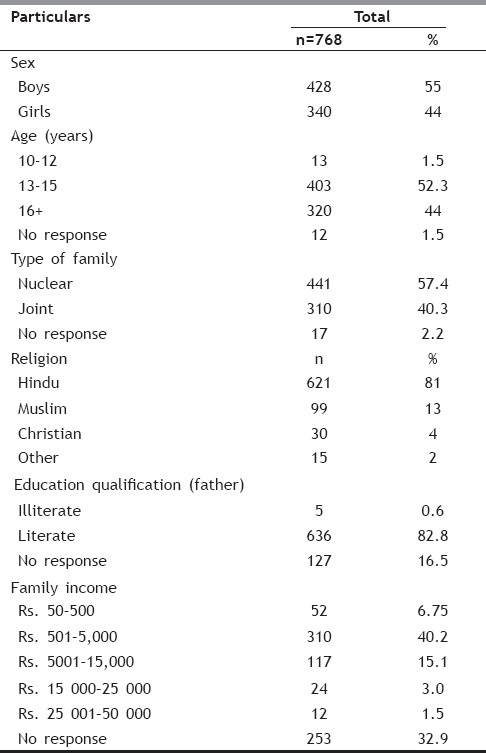
Table 2.
Changes needed for a boy to become a man as perceived by students

Table 3.
Changes needed for a girl to become a woman as perceived by students

On being asked whether they had heard about HIV/AIDS, 81% of the boys and 77% of the girls replied in affirmative. More than half of the adolescent boys and girls knew correctly, the various modes of transmission of HIV/AIDS. Three out of four students wanted more information on reproduction at school with no difference between boys and girls desire to know more [Table 4]. One third of the girls were told about menstruation by their mothers but only one fourth were explained the reason [Table 5]. Only one third of the students had heard about family planning methods [Table 6] and they knew condoms and tubectomy [Table 7]. Nearly 70% of adolescents were ready to use AFC, if it were to be set up. Less than 10% were not likely to use it, whereas the rest were not quite sure of it. Willingness to use AFC increased with age; boys and girls in the higher classes were more willing to utilize the AFC [Table 8]. The proportion of boys and girls using television and other books and magazines for information regarding reproductive health also increases with age. With increasing age, there is a rather steep decline in the percentage of boys and girls reporting parents as the source of reproductive health information, and a substantial increase with age in the percentage of adolescents, more boys, reporting friends as a source of information on reproduction and reproductive health.
Table 4.
Students opinion for getting more information on reproductive health from schools

Table 5.
Persons identified for giving information regarding menstruation among girls
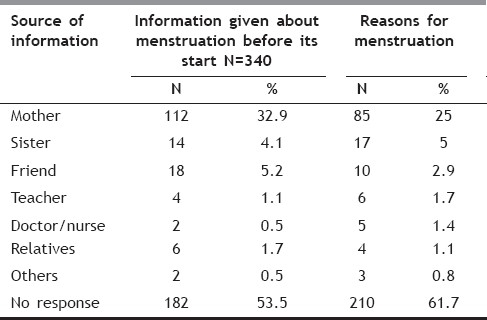
Table 6.
Students’ perception of having heard about family planning methods

Table 7.
Perception of students about names of family planning methods
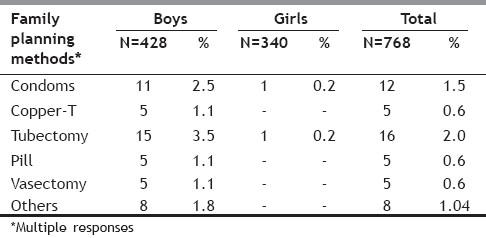
Table 8.
Readiness to use Adolescent Friendly Clinic if available (standard wise)
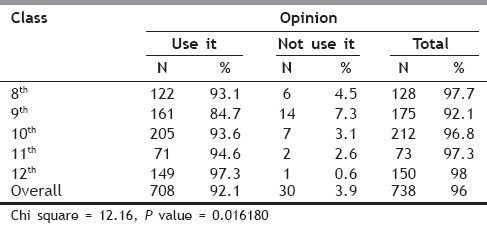
DISCUSSION
From the FGD as well as the quantitative survey, it is clear that boys and girls are aware of the external, more visible pubertal changes in themselves as well as in the opposite sex. A large proportion of boys and girls mentioned changes in the opposite sex like increase in height, change in voice, breast development, and growth of facial hair, growth of hair in private parts, onset of menstruation in girls, etc. Few of them mentioned changes that cannot be seen easily in the opposite sex like erection or ejaculation, increase in hip and waist size, muscular growth, etc.
The median age for attaining menarche for girls was 14 years. Most of them had been informed about it, mostly by their mothers, before they had their first period. A large majority did not know the biomedical reason for menstruation. Taboos and restrictions on food and activities such as being offered food separately, not being allowed to touch the idols of Gods, nor any family member, not being allowed to visit temples were thought to be right by many. Awareness was higher among older adolescents (age 14-16 and 17-20 years). This was in regard to the School Adolescent Education Programme (SAEP) training held in the rural schools.
Watsa in a study of 4709 respondents showed that adolescents received sex information usually from mass media and friends but it was not reliable. Teachers were ill equipped to clear their doubts on sex.[7] Our study shows that the most common sources of information about human reproduction were television, schoolbooks, newspapers, teachers, and friends as depicted in Figure 1. Teachers perceived that adolescents become curious about the changes taking place in them, but they lack information and opportunities for open-discussions to get answers to their queries related to reproductive health. This contributes to the confusion, shame, and guilt among adolescents.
Figure 1.
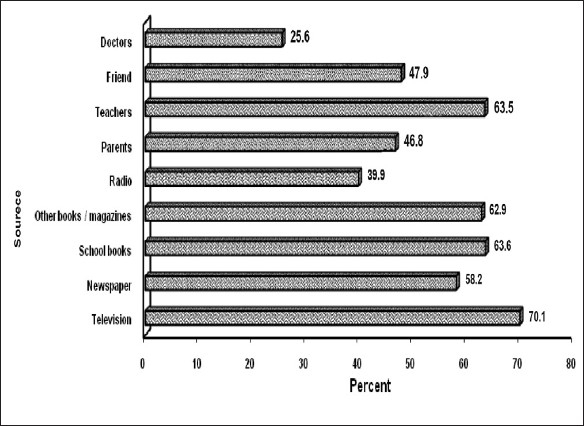
Source of receiving information about human reproduction
Francis et al.'s study of 716 school girls in Delhi observed that most frequent source of information on reproductive facts was books (53.8%) followed by friends (47.3%) in contrast to our study where television was the most common source of information followed by books and teachers.[8]
Though reproductive system and reproduction were part of the syllabus in classes 9, 10, and 11 in the old course, these topics were never taken up in the classroom, as teachers themselves hesitated and were uncomfortable in teaching these topics. They either made a passing reference to these topics or assigned them to their students for self-study. Teachers felt ill equipped to discuss reproductive health topics with their students. Teachers reported being insulted by the parents of the students when they taught the topic in school.
Teachers acknowledge the need for reproductive health information, but not all are in favor of providing sex education to school children at least in rural areas. According to them the community in the rural areas would not be comfortable with such education being imparted to students in the schools and they also feared that increased knowledge might encourage adolescents to indulge in experiments.
Sexuality is a natural and intrinsic part of an individual's personality and needs to be nurtured and developed like all other facts of life. This fact is completely ignored by parents and teachers in our society, because they themselves do not feel comfortable in discussing their issues with the youngsters. They have inhibition about discussing and expressing themselves on sex-related issues. They rather discourage the children from any form of sexual expression and encourage them to hide their sexuality. In the Indian socio-cultural setting sex is a taboo, and hence the society does not provide them with channels for being appropriately educated in this area. The adolescents generally do not get adequate advice and guidance regarding, various aspects like puberty, menarche, reproductive health, from their parents and teachers or any other groups of professionals.
CONCLUSION
Inadequate knowledge about understanding of reproductive system and reproductive health was found among rural students and teachers. Most of them expressed a desire to know more about reproductive health as part of the school curriculum. Boys and girls felt attraction towards the opposite sex. Relatively less social support was provided to boys as compared to girls, in terms of reproductive changes occurring in body. Majority of the adolescents expressed their willingness to avail the services of an AFC. Study pointed toward the need for information on reproductive system, human reproduction, and related issues and reproductive health for the students and teachers. Teachers’ orientation to “adolescent health care” is needed.
ACKNOWLEDGEMENTS
I express my sincere thanks to, Government of India, for funding this study. Thanks to Mr Chaitanyaprasad, Dy Secretary, Health, Government of India for his interest, encouragement and help for the project and World Health Organization, India office in general and Dr Arvind Mathur in particular for providing technical guidance.
Footnotes
Source of Support: Government of India.
Conflict of Interest: None declared.
REFERENCES
- 1.Goldenring J. A Review provided by VeriMed Healthcare Network, Medline plus. 2004 [Google Scholar]
- 2.Senderowitz J. World Bank Discussion Paper No. 272. Washington, D.C: World Bank; 1995. Adolescent health: reassessing the passage to adulthood. [Google Scholar]
- 3.Guidelines on Reproductive Health. 1995. Available from: http://www.piere@unfpa.org, http://www.unescap.org, http://www.ijppediatricsindia.org - UNFPA .
- 4.Mahajan P, Sharma N. Awareness level of Adolescent Girls Regarding HIV/AIDS (A comparative study of rural and urban areas of Jammu) J Hum Ecol. 2004;17:313–4. [Google Scholar]
- 5.Bhan NB, Mahajan P, Sondhi M. Awareness Regarding Sex Knowledge Among Adolescent Girls (16-20 years) Anthropologist. 2004;6:101–3. [Google Scholar]
- 6.Dean AG, Coulombier D, Brendel KA, Smith DC, Burton AG, Dicker RC, et al. Epi_Info, Version 6.04_d. Centers for Disease Control and Prevention. Atlanta, Georgia, USA: 2001. A word processing, Database, and Statistical Programme for Public Health on IBM-compatible Microcomputers. [Google Scholar]
- 7.Watsa MC. Youth Sexuality.Mumbai (SECERT) Family Planning Association of India. 1994 [Google Scholar]
- 8.Francis PT, Gill IS, Chawdhary S. Knowledge, belief and attitude regarding AIDS, STDs and human sexuality among senior secondary students. Indian J Community Med. 1994;19:16–20. [Google Scholar]


